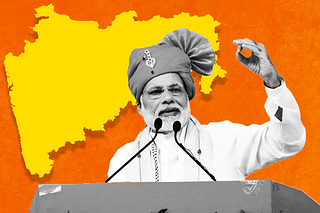Economy
Why 'Experts' Got Q3 GDP Forecasts So Wrong, Especially GDP-GVA Divergence
R Jagannathan
Mar 01, 2024, 12:18 PM | Updated 02:12 PM IST
Save & read from anywhere!
Bookmark stories for easy access on any device or the Swarajya app.

Most economic commentators have been flummoxed by the sharp rise in the third quarter gross domestic product (GDP) number, for it was substantially higher than 'expert' projections.
Most 'experts' were pencilling in GDP growth in the range of 6.7 per cent for the October-December quarter, but the actual number was way ahead at 8.4 per cent.
One anchor on CNBC TV-18 went on to tweet on social media platform X that there was “something odd about the current year GDP number: Q3 GDP is up 8.4% yoy (year-on-year), but GVA is up only 6.5%; (a) year ago, ie, FY23, Q3 GDP is up 4.3%, but GVA is up 4.8%. (The) Relation(ship) between GVA & GDP is confusing….”. (Note: GVA is gross value added).
There is actually nothing odd in the divergence, since GDP is actually GVA plus product taxes minus product subsidies. Also, growth is calculated on a previous period’s base, and can be exaggerated if the base is low, as it was in the third quarter of fiscal 2022-23.
So, in any quarter, if net product taxes rise sharply and subsidies stay limited, there will be a divergence. This divergence was there for a good reason in India’s case. Net taxes in Q3 this fiscal were up by a massive 32 per cent (in 2011-12 prices) and 29.1 per cent in current prices.
This superlative jump was partly the result of the low base effect, as net taxes were down 2.6 per cent in the third quarter of 2022-23 in real terms, and up only 5.1 per cent at current prices.
The 8.4 per cent GDP growth is also explainable in terms of the base effect, as the growth figure in the corresponding quarter of 2022-23 was just 4.3 per cent.
However, the implied assumption, that there must be something fishy in the GDP-GVA calculations is questionable, for taxes cannot rise substantially without commensurate underlying economic growth. What actually happens is that the period in which output is valued and taxes are paid may vary from sector to sector.
A sector with largely seasonal sales (refrigerator and soft drinks companies, for example) may show large value-addition and tax changes quarter to quarter. This implies that GDP-GVA data may reconcile only over longer periods beyond a year.
Even in individual cases, returns are filed in July the following year, which means tax refunds and additional tax payments for the previous year happen only in the following fiscal year.
So what are the real takeouts from the latest GDP data?
First, expert forecasting must be taken with bags of salt, for no expert can predict the actual change in a complex politico-economic environment. In this fiscal, the economy was probably less impacted by disruptions like the Ukraine war than in 2022-23.
Like weather forecasting, there are simply too many factors impacting economic outcomes in a complex adaptive system like the Indian economy. Forecasts should be taken only as directional indicators, nothing more.
Second, the huge counter-cyclical fiscal roles played by governments makes a huge difference to how the GDP-GVA divergence plays out. Post-Covid, most governments have been busy opening the fiscal taps, resulting in significant increases to both subsidies in current periods and product taxes in subsequent periods, as the same subsidy payments come back as taxes paid on consumer spends.
The huge fiscal expansions in the US and Europe, and the more moderate expansion in India, are now making their way back as tax revenues. Some of the buoyancy is also the result of inflation. This shows up in buoyant goods and services tax (GST) receipts of Rs 1.6-1.7 lakh crore in terms of monthly average.
The high growth in personal taxes, which have overtaken corporate tax payments as a result of improved compliance, is also a contributory factor to this buoyancy.
Third, the pattern of sectoral growth, both in Q3 and in the second advance estimates for the whole of fiscal 2023-24, gives us cause for continued optimism.
In Q3, real GVA growth was driven by manufacturing (11.6 per cent), construction (9.5 per cent), utilities (electricity, water, etc, 9 per cent), mining (7.5 per cent) and financial and other services (7 per cent).
The second advance estimates for the whole of fiscal 2023-24 (in which only March remains) shows growth of 10.7 per cent in construction, 8.5 per cent in manufacturing, 8.2 per cent in financial and other services, 7.5 per cent in utilities, and 8.1 per cent in mining and minerals. (You can get the full data minus the 'expert' commentary here)
Despite the La Nina effect on agriculture this year, the economy is growing like gang-busters.
India is the fastest growing large economy and may continue to remain so next year too. And it is doing so in the most adverse of global circumstances. That tells us something the data doesn’t.
Save & read from anywhere!
Bookmark stories for easy access on any device or the Swarajya app.
Jagannathan is Editorial Director, Swarajya. He tweets at @TheJaggi.
Introducing ElectionsHQ + 50 Ground Reports Project
The 2024 elections might seem easy to guess, but there are some important questions that shouldn't be missed.
Do freebies still sway voters? Do people prioritise infrastructure when voting? How will Punjab vote?
The answers to these questions provide great insights into where we, as a country, are headed in the years to come.
Swarajya is starting a project with an aim to do 50 solid ground stories and a smart commentary service on WhatsApp, a one-of-a-kind. We'd love your support during this election season.
Click below to contribute.





